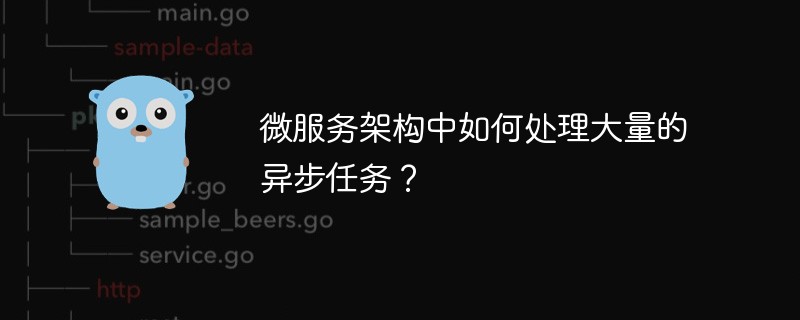Java framework and microservice architecture can be integrated through the following steps: Create microservices. Define API routes. Handle incoming requests. Return response. Configuration framework. Integration simplifies microservice development and provides capabilities such as REST API processing, configuration management, and logging. With this guide, you can effectively integrate Java frameworks into your microservices solutions.

Practical integration of Java framework and microservice architecture
In modern software development, microservice architecture has been widely adopted. It decomposes applications into a series of loosely coupled, independently deployable services. To simplify microservice development, you can use Java frameworks such as Spring Boot and Dropwizard, which provide a range of useful features.
Integration steps:
- Create a microservice: Create a Java microservice using Spring Boot or Dropwizard.
- Define API routing: Determine the API endpoints exposed by the microservice.
- Handle incoming requests: Use web components provided by the framework (such as Spring MVC or Jersey) to handle incoming HTTP requests.
- Return response: Return an appropriate HTTP response based on the result of request processing.
- Configure the framework: Configure the framework as needed, such as setting ports, TLS, and logging.
Practical case:
In order to demonstrate the integration of Java framework and microservice architecture, let us create a simple user management microservice:
pom.xml
<dependency>
<groupId>org.springframework.boot</groupId>
<artifactId>spring-boot-starter-web</artifactId>
</dependency>UserController.java
@RestController
@RequestMapping("/api/users")
public class UserController {
@PostMapping
public ResponseEntity<User> createUser(@RequestBody User user) {
// ... 业务逻辑 ...
return ResponseEntity.ok(user);
}
@GetMapping("/{id}")
public ResponseEntity<User> getUser(@PathVariable("id") Long id) {
// ... 业务逻辑 ...
return ResponseEntity.ok(user);
}
// ... 更多方法 ...
}application.properties
server.port=8080
Run the microservice:
mvn spring-boot:run
This microservice exposes two API endpoints: /api/users is used to create users, /api/users/{ id} is used to obtain the user.
By integrating Java frameworks with microservices architecture, we can simplify the development and maintenance of microservices. The framework provides a range of capabilities, including REST API handling, configuration management, and logging. By following the steps described in this article, you can effectively integrate Java frameworks into your microservices solutions.
The above is the detailed content of Integration of Java framework and microservice architecture?. For more information, please follow other related articles on the PHP Chinese website!
 go-zero与Kubernetes的实践:构建高可用性、高性能、高扩展性的容器化微服务架构Jun 22, 2023 am 09:26 AM
go-zero与Kubernetes的实践:构建高可用性、高性能、高扩展性的容器化微服务架构Jun 22, 2023 am 09:26 AM随着互联网规模的不断扩大以及用户需求的不断增加,微服务架构的优势越来越受到重视。随之而来的是,容器化的微服务架构也变得尤为重要,它可以更好地满足高可用性、高性能、高扩展性等方面的需求。而在这个趋势下,go-zero和Kubernetes成为了最受欢迎的容器化微服务框架。本文将介绍如何使用go-zero框架和Kubernetes容器编排工具构建高可用性、高性能
 微服务架构中如何处理服务的自动化测试和部署?May 17, 2023 am 08:10 AM
微服务架构中如何处理服务的自动化测试和部署?May 17, 2023 am 08:10 AM随着互联网技术的快速发展,微服务架构也越来越被广泛应用。使用微服务架构可以有效避免单体应用的复杂度和代码耦合,提高应用的可扩展性和可维护性。然而,与单体应用不同,在微服务架构中,服务数量庞大,每个服务都需要进行自动化测试和部署,以确保服务的质量和可靠性。本文将针对微服务架构中如何处理服务的自动化测试和部署进行探讨。一、微服务架构中的自动化测试自动化测试是保证
 微服务架构中如何处理服务的可维护性和可读性?May 16, 2023 pm 05:21 PM
微服务架构中如何处理服务的可维护性和可读性?May 16, 2023 pm 05:21 PM在当前的软件开发中,微服务架构已经逐渐成为了一个关注的焦点。微服务架构是指将应用程序拆分成多个小型的服务,并且每个服务都可以独立部署和运行。这种架构风格可以提高应用程序的可扩展性和可靠性,但也会带来新的挑战。其中最重要的挑战之一就是如何处理微服务的可维护性和可读性问题。微服务的可维护性在微服务架构中,每个服务都要负责单独的业务领域或模块。这样可以使得服务之间
 微服务架构中如何处理大量的异步任务?May 17, 2023 pm 10:01 PM
微服务架构中如何处理大量的异步任务?May 17, 2023 pm 10:01 PM随着云计算和大数据时代的到来,解决并发问题已经成为了互联网架构设计的关键。而微服务架构作为云时代下的一种较为先进的架构方式,其本身的异步任务处理能力成为了其优势之一。但是,当异步任务数量急剧增加时,也会给微服务架构的性能和稳定性带来挑战。本文将从异步任务的定义、微服务架构的异步任务处理原理以及解决方案等方面进行探讨。一、异步任务的定义和类型异步任务,顾名思义
 微服务架构中如何实现服务的版本回滚和升级?May 16, 2023 pm 03:01 PM
微服务架构中如何实现服务的版本回滚和升级?May 16, 2023 pm 03:01 PM随着互联网技术的快速发展,微服务架构逐渐成为了互联网企业中技术部门的主流选择。相对于单体架构,微服务架构可以更加灵活、高效地进行系统开发和运维。在微服务架构中,每个服务都是一个相对独立的单元,可以独立部署、升级和回滚。因此,在微服务架构中,服务升级和回滚是非常常见的操作。那么,如何在微服务架构中实现服务的版本回滚和升级呢?本文将对此进行探讨和介绍。一、服务版
 微服务架构中如何保证数据一致性?May 17, 2023 am 09:31 AM
微服务架构中如何保证数据一致性?May 17, 2023 am 09:31 AM随着云计算和大数据技术的快速发展,微服务架构已经成为很多企业重要的技术选型之一,它通过将应用程序拆分成多个小型的服务来降低应用开发和维护的复杂性,同时可以支持灵活性和可伸缩性,提高应用程序的性能和可用性。然而,在微服务架构中,数据一致性是一个重要的挑战。由于微服务间的相互独立性,每个服务都拥有自己的本地数据存储,因此在多个服务之间保持数据一致性是一个非常复杂
 微服务架构如何实现服务间的并发控制?May 17, 2023 pm 08:21 PM
微服务架构如何实现服务间的并发控制?May 17, 2023 pm 08:21 PM随着信息技术的不断发展,微服务架构已成为当今互联网领域中最受欢迎的架构之一。微服务架构采用小型服务组件化的方式来构建应用程序,每个服务组件都独立运行,并通过轻量级的通信机制相互协作。但是,由于微服务架构中服务之间的高度耦合和紧密联系,服务之间的并发控制问题不可避免地会出现。在微服务架构中,服务之间的并发控制问题主要存在于以下两个方面:相互之间的数据依赖:不同
 微服务架构中如何处理服务间的异步通信问题?May 18, 2023 am 08:09 AM
微服务架构中如何处理服务间的异步通信问题?May 18, 2023 am 08:09 AM随着互联网技术的发展,各种应用系统的规模和复杂度也在不断增加。传统的单体应用架构难以应对快速增长的访问量和日益复杂的业务逻辑。因此,微服务架构成为了许多企业和开发者的选择。微服务架构将单一的应用拆分成多个独立的服务,通过各自的API接口实现服务间的交互和通信。这种将应用程序划分为小型服务的方式不仅能够方便开发和部署,而且还能够提高整体的可伸缩性和可维护性。但


Hot AI Tools

Undresser.AI Undress
AI-powered app for creating realistic nude photos

AI Clothes Remover
Online AI tool for removing clothes from photos.

Undress AI Tool
Undress images for free

Clothoff.io
AI clothes remover

AI Hentai Generator
Generate AI Hentai for free.

Hot Article

Hot Tools

Dreamweaver Mac version
Visual web development tools

mPDF
mPDF is a PHP library that can generate PDF files from UTF-8 encoded HTML. The original author, Ian Back, wrote mPDF to output PDF files "on the fly" from his website and handle different languages. It is slower than original scripts like HTML2FPDF and produces larger files when using Unicode fonts, but supports CSS styles etc. and has a lot of enhancements. Supports almost all languages, including RTL (Arabic and Hebrew) and CJK (Chinese, Japanese and Korean). Supports nested block-level elements (such as P, DIV),

PhpStorm Mac version
The latest (2018.2.1) professional PHP integrated development tool

SublimeText3 Chinese version
Chinese version, very easy to use

MinGW - Minimalist GNU for Windows
This project is in the process of being migrated to osdn.net/projects/mingw, you can continue to follow us there. MinGW: A native Windows port of the GNU Compiler Collection (GCC), freely distributable import libraries and header files for building native Windows applications; includes extensions to the MSVC runtime to support C99 functionality. All MinGW software can run on 64-bit Windows platforms.






